Actor and singer Fernandel (1903–1971) was for more than forty years France's top comedy star. He was perhaps best-loved for his portrayal of Don Camillo. His horse-like teeth and shy manner became his trademark.

Mexican Collectors card, no. 276.
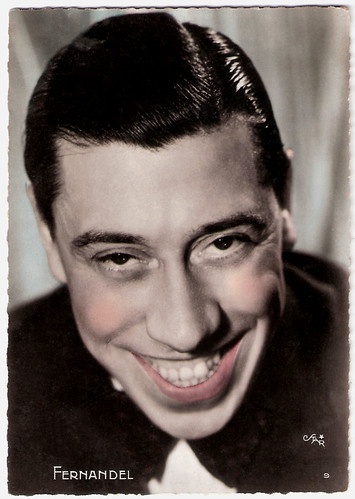
French postcard by Editions O.P., Paris, no. 9. Photo: Star.
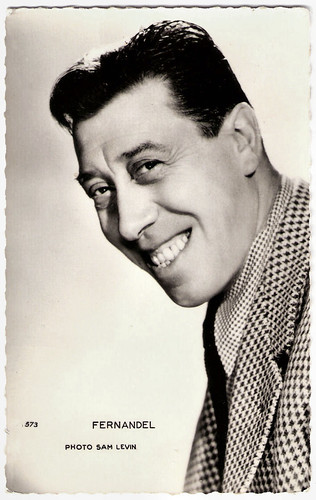
French postcard by Editions P.I., no. 573. Photo: Sam Lévin.
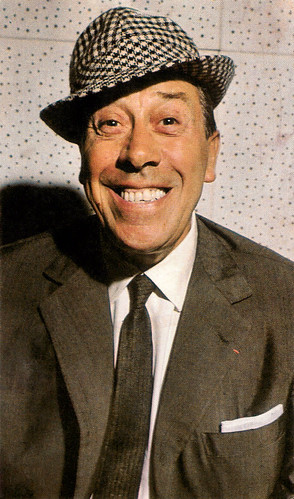
French postcard by PSG, offered by Corvisart, Epinal no. 443. Photo: Nisak.
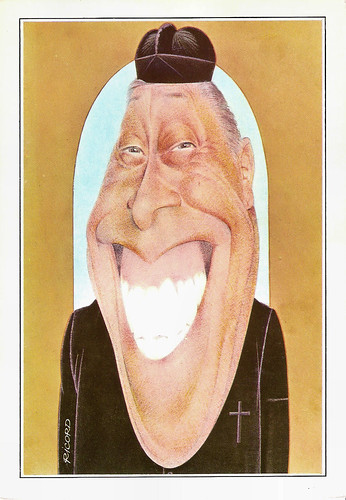
French postcard in the Les Grandes Gueules Series by Dervish International Publications, Paris, no. 105. Illustration: Ricord.
Fernandel was born as Fernand Joseph Désiré Contandin in Marseille, France, as the son of a music-hall entertainer. His brother Fransined would become an actor too.
Fernandel began performing while still a child. In his teens, he supported himself in a variety of jobs while gaining experience as an amateur comedian and singer. In 1922 he turned professional, soon becoming popular in vaudeville, operettas, and music-hall revues. He married with Henriette Manse in 1925.
His film debut was in Le blanc et le noir/White and Black (Robert Florey, Marc Allégret, 1930) at the side of Raimu. Marc Allégret was also the director of his first successful film La meilleure Bobonne (Marc Allégret, Claude Heymann, 1930). Very popular was his serious role in the screen adaptation of Guy de Maupassant's Le Rosier de Madame Husson/The Virgin Man (Bernard-Deschamps, 1932).
Writer/director Marcel Pagnol used his immense talent and great sensitivity in a series of films: as a half-witted in Angèle (1934), Regain/Harvest (1937), Le Schpountz/Heartbeat (1938), La Fille du puisatier/The Well-Digger's Daughter (1940), and later as a scrupulously honest schoolteacher in Topaze (1951).
Fernandel became a typical actor of the comedy genre: popular, common, likeable and with a concealed grain of drama. For more than four decades and in nearly 150 films he was France's most popular comedy star.
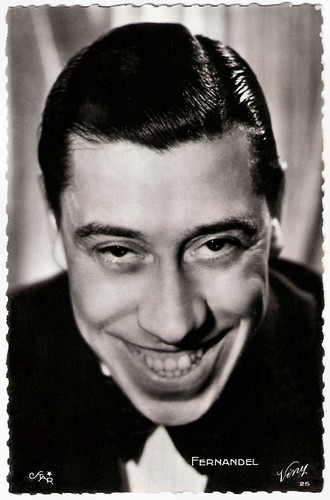
French postcard by Viny, no. 25. Photo: Star.
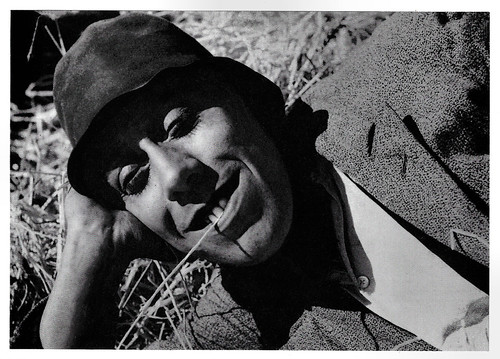
Swiss postcard by News Productions, Baulmes, no. 56505. Photo: Cinémathèque Suisse. Fernandel in Angèle (Marcel Pagnol, 1934).
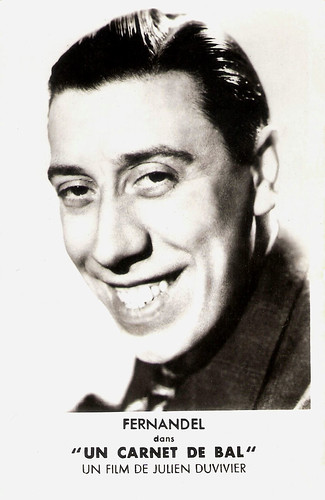
French postcard by Edition Chantal, Paris. Photo: publicity still for Un Carnet de Bal/Dance Program (Julien Duvivier, 1937).
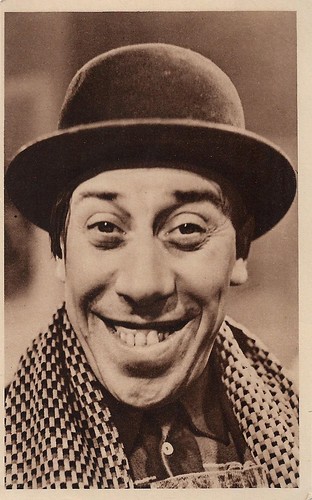
French postcard. Photo: Les Films Marcel Pagnol. Fernandel in Regain (Marcel Pagnol, 1937).
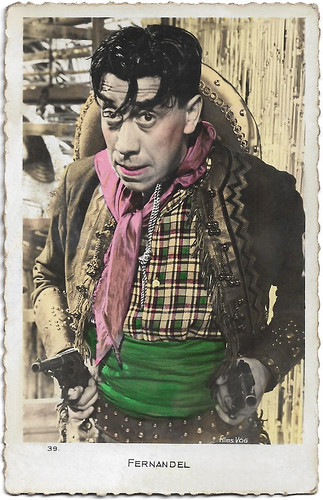
French postcard, no. 39. Photo: Les films Vog. Fernandel in Ernest le rebelle (Christian-Jaque, 1938). The story evolves in South America.
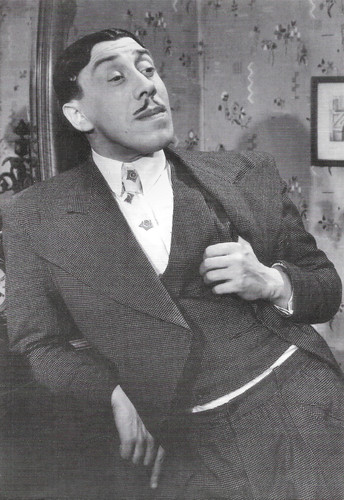
French postcard by DR MPC (Marcel Pagnol Com), no. 7. Photo: Roger Corbeau. Fernandel in Le Schpountz/Heartbeat (Marcel Pagnol, 1938).

French postcard in the Collection Cinéma by Editions Le Malibran, Paris / Nancy, no. CF 51. Michel Simon and Fernandel in Fric-Frac/Break-In (Maurice Lehmann, Claude Autant-Lara (uncredited), 1939).
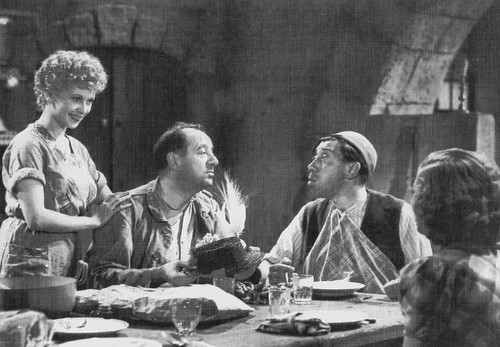
French postcard in the Raimu series by MPC (Marcel Pagnol Com), no. 46. Raimu, Fernandel and Josette Day in La fille du Puisatier (Marcel Pagnol, 1940), written by Marcel Pagnol.
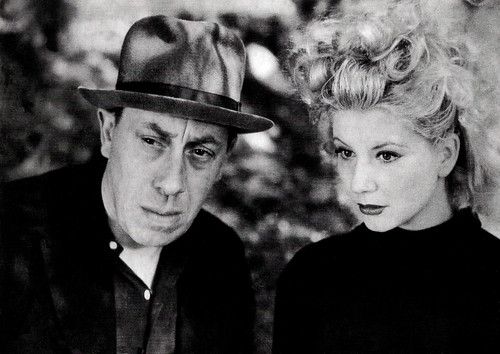
French postcard by MPC (Marcel Pagnol Com), no. 39. Photo: Henri Moiroud. Fernandel and Jacqueline Pagnol in Nais (Raymond Leboursier, Marcel Pagnol, 1945).
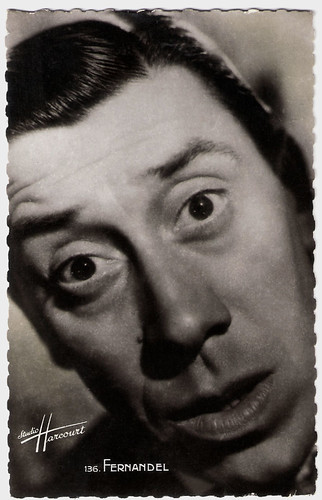
French postcard by S.E.R.P., Paris, no. 136. Photo: Studio Harcourt.
Fernandel was perhaps best loved for his portrayal of Don Camillo, the humorously indomitable priest of a little Italian parish at war with the village's communist mayor, Peppone (played by Gino Cervi) in the popular film series of the 1950s.
Director Julien Duvivier first brought the books by Giovanni Guareschi to life in Le Petit monde de Don Camillo/The Little World of Don Camillo (1951) and Le Retour de Don Camillo/The Return of Don Camillo (1953). With other directors, Fernandel made La Grande bagarre de Don Camillo/Don Camillo's Last Round (Carmine Gallone, 1955), Don Camillo Monseigneur/Don Camillo: Monsignor (Carmine Gallone, 1961), and Don Camillo en Russie/Don Camillo in Moscow (Luigi Comencini, 1965).
Among his other successes were L'auberge rouge/The Red Inn (Claude Autant-Lara, 1951), Ali Baba et les quarante voleurs/Ali Baba and the Forty Thieves (Jacques Becker, 1954) and La Vache et le Prisonnier/The Cow and I (Henri Verneuil, 1959). He also appeared in Italian and American films. His first Hollywood motion picture was Around the World in Eighty Days (Michael Anderson, 1956) in which he played David Niven's coachman. His popular performance in that film led to starring with Bob Hope and Anita Ekberg in the comedy Paris Holiday (Gerd Oswald, 1958).
In addition to acting, Fernandel also directed or co-produced several of his own films. In 1970 Fernandel started with the shooting of the sixth Don Camillo film, Don Camillo et les contestastaires/Don Camillo and the Youth of Today, directed by Christian-Jaque. After a few weeks, he had to stop because of poor health.
Shortly afterwards Fernandel died from lung cancer. He is buried in the Cimetière de Passy, Paris, France. Fernandel and his wife Henriette had three children, including actor Franck Fernandel and actress Josette Contandin.
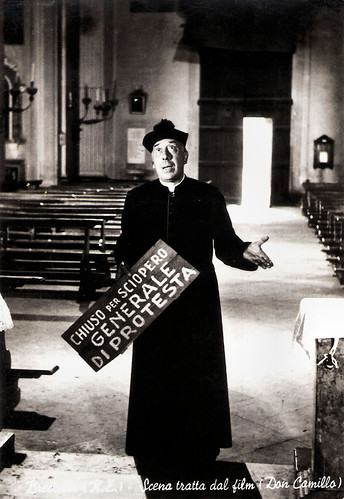
Italian postcard by Ediz. Mussetti-Zanuichelli-Righi-Mingori, Brescello. Photo: Civirani, Roma. Fernandel in Don Camillo/Le petit monde de Don Camillo/The Little World of Don Camillo (Julien Duvivier, 1952).
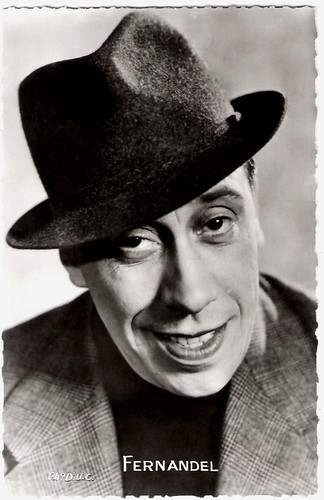
French postcard by Editions Chantal, Rueil. Photo: D.U.C.
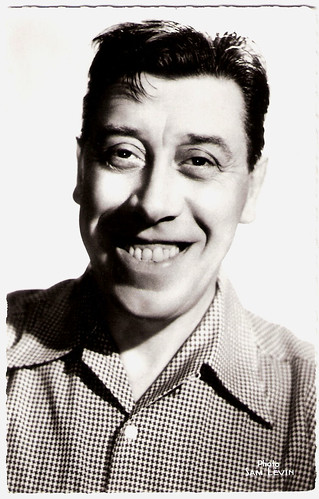
French postcard by Editions du Globe, no. 304. Photo: Sam Lévin.
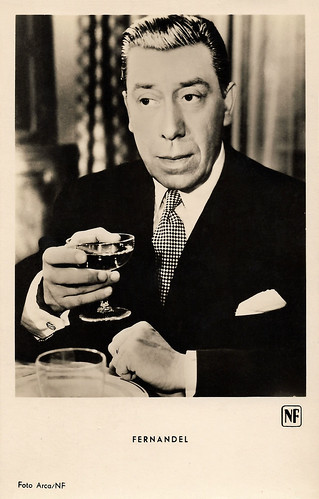
West German postcard by Kunst und Bild, Berlin, no. A 872. Photo: Arca / NF. Fernandel in Le fruit défendu/Forbidden Fruit (Henri Verneuil, 1952).
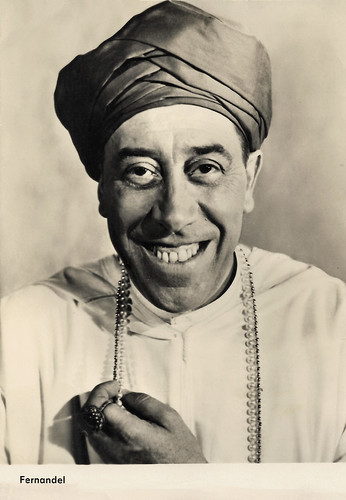
East German postcard by VEB Progress Film-Vertrieb, Berlin, no. 2383, 1965. Fernandel in Ali Baba et les 40 voleurs/Ali Baba and the Forty Thieves (Jacques Becker, 1954).
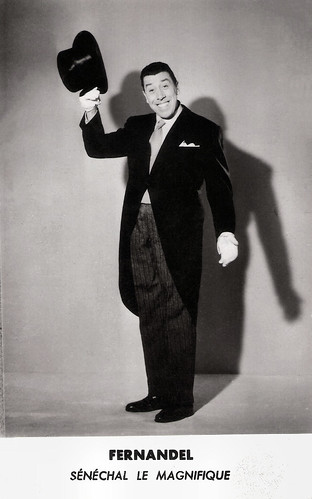
French card. Fernandel in Sénéchal le magnifique/Sénéchal the Magnificent (Jean Boyer, 1957).
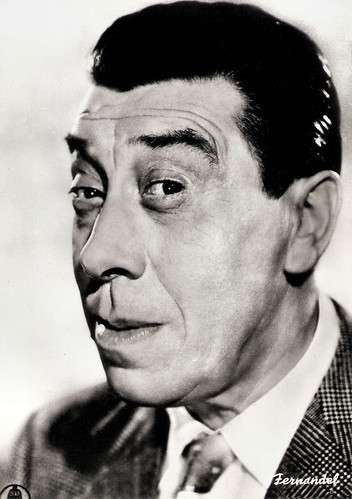
Italian postcard by Bromofoto, Milano, no. 1390. Photo: Dear Film. Fernandel in Paris Holiday (Gerd Oswald, 1958).
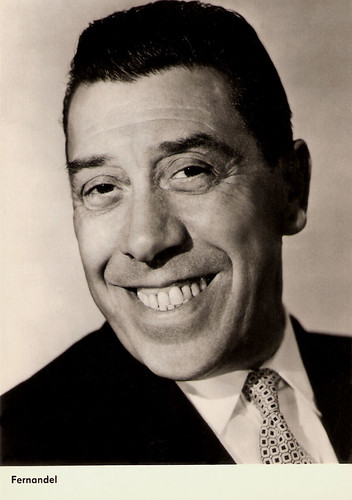
East-German postcard by VEB Progress Film-Vertrieb, Berlin, no. 2919, 1967. Retail price: 0,20 DM. Photo: Unifrancefilm.
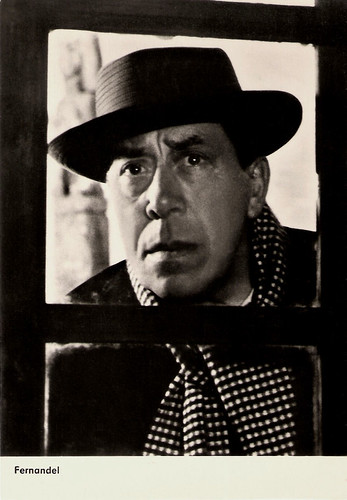
German postcard by Progress, no. 1.973, 1964. Retail price: 0,20 DM. Photo: publicity still for Le diable et les dix commandements/The Devil and the Ten Commandments (Julien Duvivier, 1962).
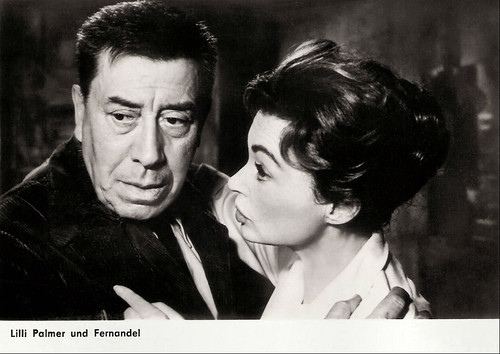
German postcard by Progress, no. 2994, 1967. Retail price: 0,20 DM. Photo: publicity still for Le voyage du père/Father's Trip (Denys de La Patellière, 1966) with Lilli Palmer.
Sources: Volker Boehm (IMDb), Wikipedia, AllMovie, and IMDb.

Mexican Collectors card, no. 276.

French postcard by Editions O.P., Paris, no. 9. Photo: Star.

French postcard by Editions P.I., no. 573. Photo: Sam Lévin.

French postcard by PSG, offered by Corvisart, Epinal no. 443. Photo: Nisak.

French postcard in the Les Grandes Gueules Series by Dervish International Publications, Paris, no. 105. Illustration: Ricord.
Popular, common, likeable and with a concealed grain of drama
Fernandel was born as Fernand Joseph Désiré Contandin in Marseille, France, as the son of a music-hall entertainer. His brother Fransined would become an actor too.
Fernandel began performing while still a child. In his teens, he supported himself in a variety of jobs while gaining experience as an amateur comedian and singer. In 1922 he turned professional, soon becoming popular in vaudeville, operettas, and music-hall revues. He married with Henriette Manse in 1925.
His film debut was in Le blanc et le noir/White and Black (Robert Florey, Marc Allégret, 1930) at the side of Raimu. Marc Allégret was also the director of his first successful film La meilleure Bobonne (Marc Allégret, Claude Heymann, 1930). Very popular was his serious role in the screen adaptation of Guy de Maupassant's Le Rosier de Madame Husson/The Virgin Man (Bernard-Deschamps, 1932).
Writer/director Marcel Pagnol used his immense talent and great sensitivity in a series of films: as a half-witted in Angèle (1934), Regain/Harvest (1937), Le Schpountz/Heartbeat (1938), La Fille du puisatier/The Well-Digger's Daughter (1940), and later as a scrupulously honest schoolteacher in Topaze (1951).
Fernandel became a typical actor of the comedy genre: popular, common, likeable and with a concealed grain of drama. For more than four decades and in nearly 150 films he was France's most popular comedy star.

French postcard by Viny, no. 25. Photo: Star.

Swiss postcard by News Productions, Baulmes, no. 56505. Photo: Cinémathèque Suisse. Fernandel in Angèle (Marcel Pagnol, 1934).

French postcard by Edition Chantal, Paris. Photo: publicity still for Un Carnet de Bal/Dance Program (Julien Duvivier, 1937).

French postcard. Photo: Les Films Marcel Pagnol. Fernandel in Regain (Marcel Pagnol, 1937).

French postcard, no. 39. Photo: Les films Vog. Fernandel in Ernest le rebelle (Christian-Jaque, 1938). The story evolves in South America.

French postcard by DR MPC (Marcel Pagnol Com), no. 7. Photo: Roger Corbeau. Fernandel in Le Schpountz/Heartbeat (Marcel Pagnol, 1938).

French postcard in the Collection Cinéma by Editions Le Malibran, Paris / Nancy, no. CF 51. Michel Simon and Fernandel in Fric-Frac/Break-In (Maurice Lehmann, Claude Autant-Lara (uncredited), 1939).

French postcard in the Raimu series by MPC (Marcel Pagnol Com), no. 46. Raimu, Fernandel and Josette Day in La fille du Puisatier (Marcel Pagnol, 1940), written by Marcel Pagnol.

French postcard by MPC (Marcel Pagnol Com), no. 39. Photo: Henri Moiroud. Fernandel and Jacqueline Pagnol in Nais (Raymond Leboursier, Marcel Pagnol, 1945).

French postcard by S.E.R.P., Paris, no. 136. Photo: Studio Harcourt.
Don Camillo
Fernandel was perhaps best loved for his portrayal of Don Camillo, the humorously indomitable priest of a little Italian parish at war with the village's communist mayor, Peppone (played by Gino Cervi) in the popular film series of the 1950s.
Director Julien Duvivier first brought the books by Giovanni Guareschi to life in Le Petit monde de Don Camillo/The Little World of Don Camillo (1951) and Le Retour de Don Camillo/The Return of Don Camillo (1953). With other directors, Fernandel made La Grande bagarre de Don Camillo/Don Camillo's Last Round (Carmine Gallone, 1955), Don Camillo Monseigneur/Don Camillo: Monsignor (Carmine Gallone, 1961), and Don Camillo en Russie/Don Camillo in Moscow (Luigi Comencini, 1965).
Among his other successes were L'auberge rouge/The Red Inn (Claude Autant-Lara, 1951), Ali Baba et les quarante voleurs/Ali Baba and the Forty Thieves (Jacques Becker, 1954) and La Vache et le Prisonnier/The Cow and I (Henri Verneuil, 1959). He also appeared in Italian and American films. His first Hollywood motion picture was Around the World in Eighty Days (Michael Anderson, 1956) in which he played David Niven's coachman. His popular performance in that film led to starring with Bob Hope and Anita Ekberg in the comedy Paris Holiday (Gerd Oswald, 1958).
In addition to acting, Fernandel also directed or co-produced several of his own films. In 1970 Fernandel started with the shooting of the sixth Don Camillo film, Don Camillo et les contestastaires/Don Camillo and the Youth of Today, directed by Christian-Jaque. After a few weeks, he had to stop because of poor health.
Shortly afterwards Fernandel died from lung cancer. He is buried in the Cimetière de Passy, Paris, France. Fernandel and his wife Henriette had three children, including actor Franck Fernandel and actress Josette Contandin.

Italian postcard by Ediz. Mussetti-Zanuichelli-Righi-Mingori, Brescello. Photo: Civirani, Roma. Fernandel in Don Camillo/Le petit monde de Don Camillo/The Little World of Don Camillo (Julien Duvivier, 1952).

French postcard by Editions Chantal, Rueil. Photo: D.U.C.

French postcard by Editions du Globe, no. 304. Photo: Sam Lévin.

West German postcard by Kunst und Bild, Berlin, no. A 872. Photo: Arca / NF. Fernandel in Le fruit défendu/Forbidden Fruit (Henri Verneuil, 1952).

East German postcard by VEB Progress Film-Vertrieb, Berlin, no. 2383, 1965. Fernandel in Ali Baba et les 40 voleurs/Ali Baba and the Forty Thieves (Jacques Becker, 1954).

French card. Fernandel in Sénéchal le magnifique/Sénéchal the Magnificent (Jean Boyer, 1957).

Italian postcard by Bromofoto, Milano, no. 1390. Photo: Dear Film. Fernandel in Paris Holiday (Gerd Oswald, 1958).

East-German postcard by VEB Progress Film-Vertrieb, Berlin, no. 2919, 1967. Retail price: 0,20 DM. Photo: Unifrancefilm.

German postcard by Progress, no. 1.973, 1964. Retail price: 0,20 DM. Photo: publicity still for Le diable et les dix commandements/The Devil and the Ten Commandments (Julien Duvivier, 1962).

German postcard by Progress, no. 2994, 1967. Retail price: 0,20 DM. Photo: publicity still for Le voyage du père/Father's Trip (Denys de La Patellière, 1966) with Lilli Palmer.
Sources: Volker Boehm (IMDb), Wikipedia, AllMovie, and IMDb.
12 comments:
Interesting note about the "concealed grain of drama" in his popular roles. There is something very appealing about that kind of subtext and restraint in a performer.
I seem to remember his priest role. Wonderful, entertaining post ... as usual!!! Happy PFF!
Ahh! I really enjoyed this one! Don Camillo movies still appear regularly on Italian TV even to this day! Happy PFF!
I love this man's face. A person doesn't have to have a handsome face to become a well-known actor. It's all about the personality.
Lovely post! Happy PFF!
He turn "defects" into qualities. :)
Your blog is in my Top 100 across all categories.
:)
I thought it was Fred McMurray when I first saw his picture! Interesting post, as always.
And I had never heard of him. Now I know. Happy PFF.
Fun to see pictures of actors from other countries. This fellow is not handsome but looks like he would be great guy and most definitely had a multitude of fans.
I think he has a gret, fun look!
Such a depth of character in that man's face! Intriguing! He looks a lot like Humphrey Bogart to me! Fascinating post!
Love the Don Camillo movies. Very talented man.
Un post para don Fernando Rey, please.
Post a Comment